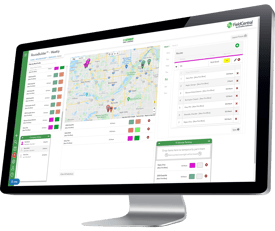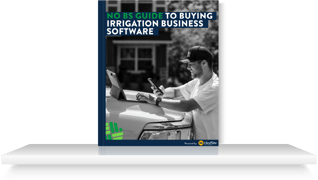
A recent study by Software Advice, a technology review site, found that the most-requested feature for field service software buyers was scheduling. At HindSite a lot of the buyers we talk to indicate that the biggest pain point in their business is managing their field workers' schedules. Managing a field worker's schedule - especially in a paper-based environment - takes time and effort and is prone to inaccuracies. Even the most diligent businesses disappoint customers - and ultimately lose money - because of the inefficiencies found when they schedule.
But scheduling doesn't have to be a time-consuming, inefficient money pit. Here are five tips that will help your green industry business schedule more efficiently and ultimately increase your revenue.
- Know who is nearby. Before I started HindSite, I owned an irrigation business based in the Twin Cities. I had a worker who lived in Eagan, and would drive to my office in Little Canada - about 30 minutes away - to grab his day's schedule, and then drive back down to his territory, which happened to be near his house in Eagan. He literally wasted an hour everyday in a car. It was terribly inefficient.
As a green industry business owner, you know that the more time your team spends actually doing work, the more money you'll be able to bill. It's really a simple concept. So one of the best ways to earn more every single day is to schedule your techs and crews so that they spend as little time as possible in their trucks, where they aren't earning money.
That can be very difficult to do in a paper-based environment. But luckily, with field service scheduling software it's much easier. For example, say a customer calls for an irrigation system repair. With software, you'll be able to access their contact record quickly, and then see what day you have a technician nearby so you can schedule that customer so that it minimizes windshield time. You can configure HindSite so that if you have someone within a mile of that customer, the day will be shaded yellow. The color-coding makes it easy for your office manager to schedule a service call that minimizes drive time. - Color Code Your Schedule. If you watch football, you've probably seen the play calling sheets NFL coaches use. They almost always are very colorful. Why? Because coaches can make faster decisions if they know that yellow are plays that will work on third and short and blue are plays to call if they expect a zone defense. Instead of reading the play, they can look at the color and make a much quicker decision.
Let your schedule work in the same way. By color-coding your schedule by information that matters to your business, you'll glean more information in a short amount of time. For example, customers who use our snow removal software are more interested in the status of each job on their schedule. So they color-code the schedule by the status of the job - is it in progress? Is it completed? That way, they can see at a glance what truck is behind or how long it will take to get to a certain property and react on the fly.
Other customers - those using irrigation business software, for example - are interested in seeing what types of service they've scheduled. Is it a repair? An installation? A startup or winterization? They color-code their service scheduling screen with information about the type of service being performed so they know what each employee is doing. - Keep a detailed customer database. Unless you just arrived from Mars, you've heard of Google. The technology giant got to be a giant because they manage a lot of data. Their algorithms can tell them what websites you've visited in the past, what email newsletters you've received and what videos you've watched on YouTube. Because they know all of this information about you, they can serve you ads that you are more likely to fit your interests and that you're more likely to click. As a result, the people that pay them - ad buyers - are more likely to pay them more. They earn more revenue as a result of their meticulous data.
You can too. For example, we have a field in our software called "Special Needs" that our customers can automatically pop-up whenever they select a customer from the service schedule screen. It's a great way to store information that's important for the scheduler to know, like that the customer only wants to be scheduled in the afternoon. That way, your scheduler can immediately suggest an afternoon appointment when the customer calls, instead of forcing the customer to repeat the request every timel. It saves you time and your customers love that they don't have to repeat a request. - Schedule recurring services at the same time. When one of my children had braces, she was required to visit the orthodontist every month for adjustments. I would have preferred to do it at 9 a.m. the second Tuesday of every month, but the orthodontist forced me to schedule every visit after I'd completed a visit. So I had to spend five minutes after each appointment scheduling the next appointment. I probably wasted at least an hour of their time doing that. It was inconvenient for everyone involved.
So if you can, schedule any recurring services at the same time. An example might be a fertilization application. If you know that you have to wait 30 days to apply the second application and another 30 days for the third, why not schedule those all at once? Then, a day or two before each application, send an email to your customer reminding them that you'll be there. You'll spend less time scheduling and more time doing more productive tasks - like marketing - that will help you grow your business
. - Send transactional emails. OK, so this isn't really a scheduling tip, but it will definitely help you grow your revenue and eliminate wasted time. Transactional emails are emails that you send related to appointments you have on your schedule. Examples include appointment confirmation emails that you send as soon as an appointment is created, reminder emails a day or two before the appointment, and completion emails sent immediately after you finished the job.
HindSite includes a service business marketing add-on, HindSite Connect, that can automate sending transactional emails. If you provide services that require someone to be at the property when you do your work, these can save you a significant amount of money on missed appointments. One of our customers indicated that they cut their average from 1 missed appointment per day to 1 every couple weeks just by sending transactional emails. It's a real time and money saver.
Implement those five tips into your scheduling routine and you're sure to turn an inefficient, time-consuming process into a well-oiled and profitable machine. Have a scheduling tip of your own to share? Drop it in the comments!
And now that you've improved how you schedule, why not improve some other areas of your business by downloading our free eBook, 33 Stupid Things Contractors Do (And How to Fix Them), today!








